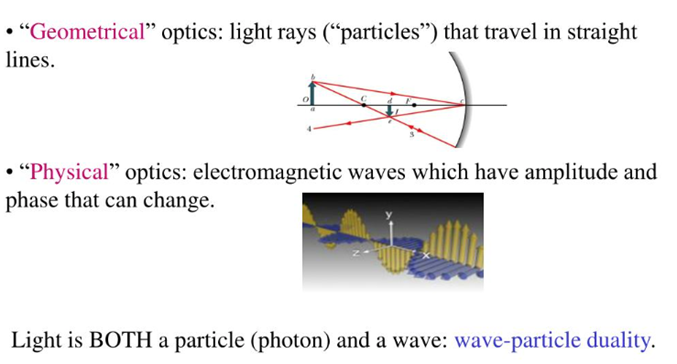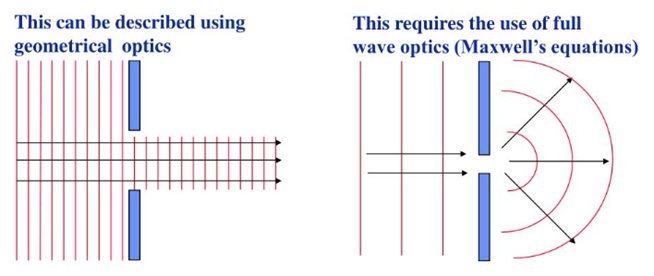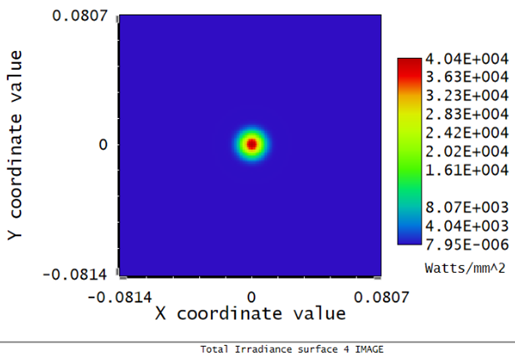Physical optical propagation (POP) refers to the behavior of light as it travels through various optical components in a system. In the context of optics and optical design, it involves the study and simulation of how light rays interact with lenses, mirrors, prisms, and other optical elements within an optical system. Physical optics is the modeling of optical systems by propagating wavefronts. The beam is represented by an array of discretely sampled points, analogous to the discrete sampling using rays for a geometric optics analysis. The entire array is then propagated through the free space between optical surfaces. At each optical surface, a transfer function is computed which transfers the beam from one side of the optical surface to the other.
Geometrical optics is the modeling of optical systems by tracing rays. Rays are imaginary lines which represent normals to the surfaces of constant phase, called the wavefront. Either rays or wavefronts can be used to represent a beam. However, rays and wavefronts are propagated differently. Rays propagate along straight lines without interfering with one another, wavefronts propagate while coherently interfering with themselves. For this reason, the ray model and the wavefront model yield different representations of the beam as it propagates through free space or through optical components. The ray method is fast, flexible, and extremely useful for modeling almost any optical system. However, rays are not well suited to modeling certain important effects, primarily diffraction.

Figure 1 Geometric optics and physical optics
When describing light paths, geometric optics describes the paths of light rays using principles of reflection and refraction. It is concerned with the image formation, location, and magnification without considering wave phenomena, as shown in Figure 2 left. POP describes light propagation using Maxwell’s equations. It includes the phenomena of interference and diffraction, providing a more detailed understanding of light behavior, especially in regions with fine details, as shown in Figure 2 right.

Figure 2 Propagation descriptions in geometric optics and physical optics
Below is a simple model for demonstration of POP. In this model, a beam from infinity is shooting in a singlet, bi-convex lens, with the material of N15. The beam focuses at 49 mm away. Figure 3 and figure 4 display the system data and a 3D layout respectively.

Figure 3 Lens data of the singlet model

Figure 4 The 3D layout of the model
From the Physical Optics tab, when surfaces 1 and 4 are selected as start and end surfaces, Zemax offers the irradiance distribution in the image plane, as shown in Figure 5. Figure 5 also shows propagation parameters at the image plane, including beam width, peak and total power. Additional pilot beam data includes the radial beam size, beam waist, position, and Rayleigh range. The pilot beam is an ideal Gaussian beam, with a waist, beam size, phase radius, and relative z position. The initial parameters may be generated by fitting the Gaussian beam equations to the initial distribution. The pilot beam is then propagated from surface to surface. At each surface, new beam parameters, such as the new waist, phase radius, or position are computed. The properties of the pilot beam are then used to determine if the actual distribution is inside or outside the Rayleigh range, and what propagation algorithms are appropriate.


Figure 5 Irradiance distribution in the image plane
The phase distribution in the image plane can be retrieved in the Display tab. The descriptions below reveal additional phase information, including phase in the center, and all phase distribution inside the spot.
For both irradiance and phase display, Zemax computes the beam irradiance or phase on a plane tangent to the chief ray at the point where the chief ray intercepts the surface. The orientation matrix of the plane may be determined from the propagation report. The irradiance or phase data is shown after the beam refracts into, or reflects from, the end surface. The chief ray representing the center of the beam will generally intercept the surface at some angle of incidence other than zero, and the surface normal will generally be at some angle to the local Z axis.


Figure 6 Phase distribution in the image plane
This example demonstrates basic information regarding the POP process. Basically, the POP considers light as an electromagnetic wave. It involves the study of interference, diffraction, and polarization phenomena, acknowledging the wave-like characteristics of light. Physical Optics offers insights into aberrations by considering wavefront distortions. It provides a more comprehensive understanding of aberrations and their impact on image quality.
In summary, while geometric optics provides a simplified and ray-based model suitable for understanding the macroscopic behavior of light in optical systems, physical optics delves into the wave nature of light, providing a more detailed description of light propagation, especially in scenarios involving smaller scales and wave interactions.
Jan 23, 2024 10:36:23 AM
